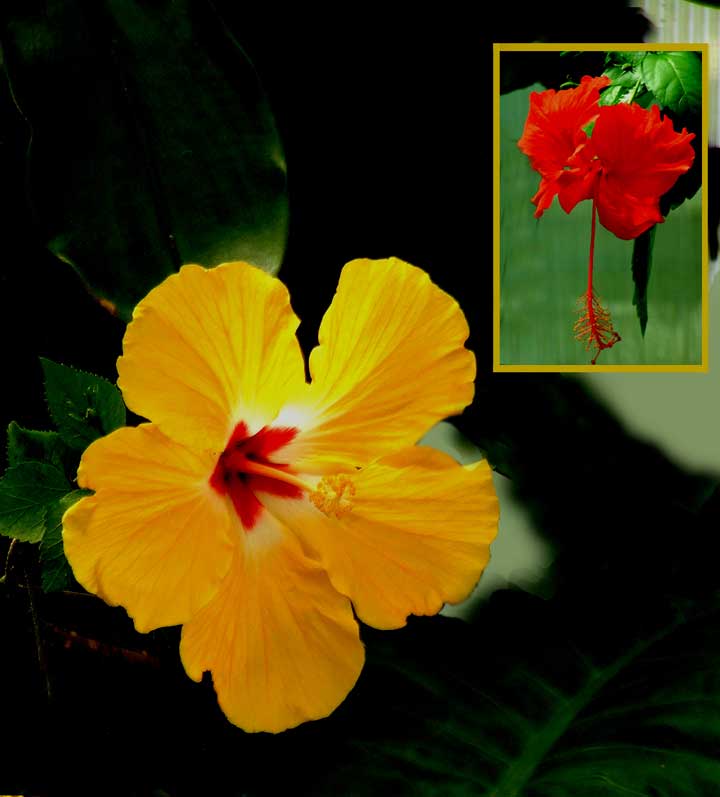Aroids and other genera in the Collection Take the Tour Now? Orchids
The
Exotic Rainforest
The images on this website are copyright protected. Please contact us before any reuse.
Hibiscus
Sp. and
Hybrids
Is it Tropical? Or is it Hardy?

as well as numerous hybrids
Queen of the Tropics, Pua Aloalo, Chinese Hibiscus
No other flower says "tropical" as quickly as the Hibiscus. Almost every woman who ever visits the tropics must have a photo taken with a Hibiscus in her hair. Even though Hawaii is the land of orchids it may surprise you to find out that the state's official flower is not an orchid. It is the Hibiscus. But a specific Hibiscus species. On the 6th of June, 1988, the strikingly delicate pale yellow Hibiscus, which on the islands is called "Pua Aloalo", became the official state flower of Hawaii. Now the golden yellow flower in our photo is not the "official" flower of Hawaii. But it is similar and that's because it was hybridized from a combination of the Hibiscus species. And the yellow one is a hardy species. It will grow outdoors in colder climates. Hibiscus are now hybridized to a point where the original species are almost impossible to decipher and our specimens are definitely hybrids.
Hawaii's state flower Hibiscus rosa-sinensis originated in the Pacific Islands, China and Asia. The flower is also the national flower of Malaysia and can be commonly seen in Singapore and other neighboring countries. Hibiscus rosa-sinensis and Hibiscus brackenridgei are true tropical hibiscus and are members of the Malvaceae family. Other relatives of the Hibiscus are the Confederate Rose, Rose-of-Sharon, the hardy Hibiscus sometimes grown in more north states, okra, cotton, hollyhock and others.
Botanists believe there were only five original species of tropical hibiscus that were native to Hawaii. But the island's tropical plant growers began to hybridize their native species with other varieties imported into the islands and managed to produce a wide variety of colors and sizes, many of which are available at nurseries all over the United States. There are literally thousands of color combinations with the exception of true blue and black. Blossoms can range from just a couple of inches in diameter to well over 30cm (12 inches)! Our yellow specimen has flowers approximately 20cm (8 inches) across while the red flower is approximately 12.5cm (5 inches) and sometimes produces doubles.
Some produce only small bushes which grow very slowly and others can shoot up to 15 feet or more! These plants grow very well in the Florida Keys and it is theorized they do so because of the Florida climate and the fast draining soil in the Keys. The Keys receive little rain in the winter but can be hit with deluges during the Spring and Summer. Some growers take a clue from this and give their plants plenty of water in the "wet season" but allow the soil to dry out during the "dry season". These plants crave full sun. Many plant collectors have begun attempting to grow Hibiscus species as a "house plant" with little success. Despite many websites such as the American Hibiscus Society advising direct sunlight, some folks simply cannot avoid trying to grow them in shade. These rare bloom well indoors.
If you plan to grow Hibiscus you should make sure you grow the types that will survive in your part of the country unless you plan to grow them in a greenhouse or atrium in colder climates. The principal way to tell the difference between a tropical and hardy hibiscus variety is to check the leaves. Tropical Hibiscus have dark green glossy leaves and flowers that are either single or double with colors of pink, red, yellow, salmon, orange, golden, or peach. And the flowers of a tropical Hibiscus flowers normally only last a single day. The hardy perennial Hibiscus has medium-green foliage with dull heart shaped leaves.. Their flowers are white, red, or pink and are generally larger than the tropical plant. Tropical Hibiscus do not like temperatures below 40 degrees F. Warmer is better.
These plants need plenty of water when it is hot as well as extremely well draining soil with plenty of peat and Perlite™ added to a rich soil. According to the American Hibiscus Society, you should fertilize with a weak fertilizer on a regular basis to keep lots of flowers blooming. Top growers often fertilize "weakly, weekly". These plants are known to attract both hummingbirds and butterflies. If you are a serious hibiscus grower you should check out the website of the American Hibiscus Society, http://www.americanhibiscus.org/index.htm